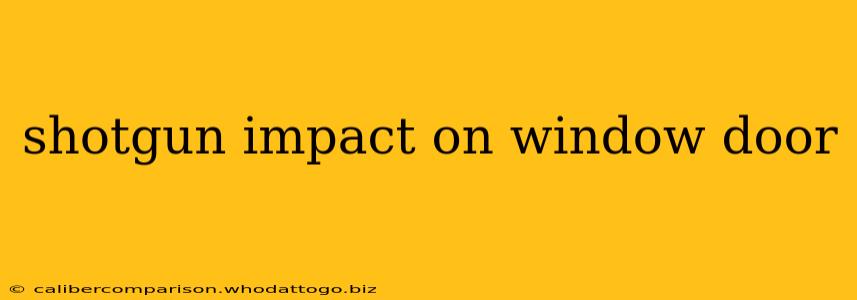Understanding the effects of a shotgun blast on window doors is crucial for several reasons, ranging from home security to forensic investigations. This article will explore the various factors influencing the damage caused by shotgun impacts on window doors, emphasizing the safety concerns and implications involved.
Factors Influencing Shotgun Impact on Window Doors
Several factors determine the extent of damage a shotgun blast inflicts on a window door:
1. Type of Shotgun and Ammunition:
- Gauge: The gauge of the shotgun (e.g., 12 gauge, 20 gauge) directly impacts the size and destructive power of the shot. Larger gauges inflict significantly more damage.
- Ammunition Type: Buckshot, birdshot, slugs—each ammunition type produces a different pattern and level of damage. Buckshot, with its multiple projectiles, creates widespread damage, while slugs deliver concentrated force to a single point. Birdshot, while less destructive than buckshot or slugs, can still cause significant damage at close range.
- Velocity: The speed at which the projectiles travel affects the penetration and overall impact. Higher velocities result in greater damage.
2. Distance from Target:
The distance between the firearm and the window door significantly influences the damage inflicted. Close-range shots create concentrated damage, potentially shattering the glass and breaching the door frame, while longer-range shots may result in less severe damage, with projectiles scattering and losing energy.
3. Composition of the Window Door:
The material and construction of the window door dramatically affect how it withstands a shotgun blast.
- Glass Thickness: Thicker glass is more resistant to penetration and shattering. Laminated glass, often found in security doors, significantly enhances resistance compared to standard annealed glass.
- Frame Material: The strength of the door frame (wood, metal, composite) impacts its ability to resist deformation and penetration. Metal frames, particularly steel, offer superior protection compared to wooden frames.
- Door Construction: Solid-core doors are more resistant to damage than hollow-core doors. Reinforcements like metal plates further enhance the door's structural integrity.
4. Angle of Impact:
The angle at which the shotgun blast strikes the window door affects the distribution of force and resulting damage. A direct hit causes the most significant impact, while an angled shot may cause less concentrated damage.
Safety Implications and Considerations
Shotgun blasts on window doors present serious safety hazards:
- Risk of Injury: Shattered glass and projectiles can cause severe injuries to individuals nearby. The force of the blast can also cause structural damage, leading to further hazards like collapse.
- Security Breach: A successful penetration of a window door compromises the security of the structure, leaving it vulnerable to intrusion.
- Forensic Significance: Analyzing the damage caused by a shotgun blast is crucial in forensic investigations to reconstruct the events and identify potential perpetrators. Factors such as shot pattern, penetration depth, and damage to the surrounding area are vital pieces of evidence.
Conclusion
Understanding the complexities of shotgun impacts on window doors requires consideration of various factors, including the type of firearm and ammunition used, the distance of the shot, the construction of the door, and the angle of impact. Awareness of these factors is crucial for assessing safety risks, enhancing security measures, and conducting forensic analyses. The information presented here is for educational purposes and should not be considered a substitute for professional advice from law enforcement or security experts.

